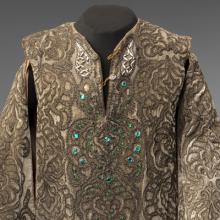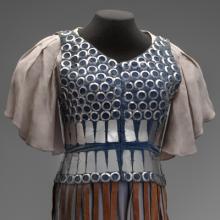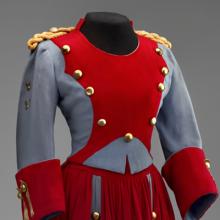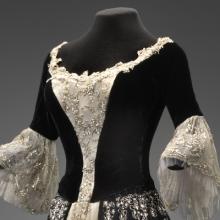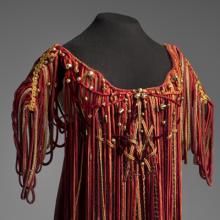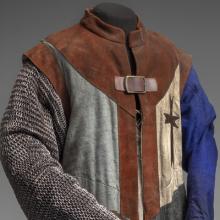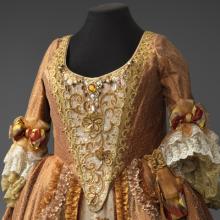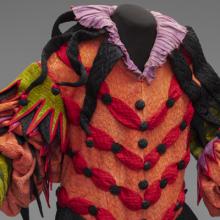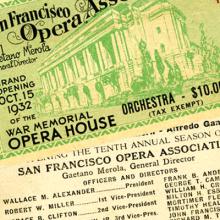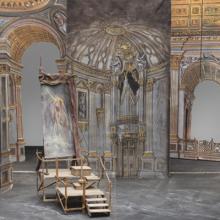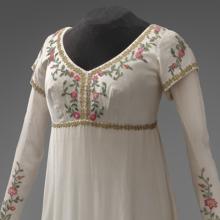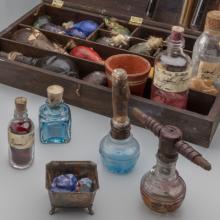Harvey Milk Terminal 1












Romeo cape and cap worn by Beniamino Gigli in Roméo et Juliette c. 1922
Courtesy of the Metropolitan Opera Archives
L2022.1002.001b, .002
San Francisco Opera’s First Season
Following San Francisco Opera’s debut on September 26, 1923, American soprano Bianca Saroya (1893–1981) and Italian tenor Beniamino Gigli (1890–1957) sang in Italian composer Umberto Giordano’s (1867–1948) Andrea Chénier. The panoramic photograph presented here is the oldest-known image of the San Francisco Opera company, taken on October 6 for a second performance of Andrea Chénier that was added due to popular demand. General Director Gaetano Merola (1881–1953) is seated at front-row-center, next to his wife Rosa. That first season, Gigli, to Merola’s left, also sang as Romeo in French composer Charles-François Gounod’s (1818–93) Roméo et Juliette.

[historic image]
The San Francisco Opera Company in Andrea Chénier October 6, 1923
George F. Courser (active early 20th century)
Exposition Auditorium, San Francisco
Courtesy of San Francisco Opera Archives
R2022.1001.012
Brünnhilde costume and helmet worn by Kirsten Flagstad in Die Walküre c. 1935
Courtesy of the Metropolitan Opera Archives
L2022.1002.003a-b; L2022.1002.004a-c
Kirsten Flagstad, Die Walküre
When San Francisco Opera presented German composer Wilhelm Richard Wagner’s (1813–83) complete Der Ring des Nibelungen for the first time in 1935, it announced the company’s arrival as a world-renowned center for opera. The monumental four-part series known as the Ring cycle is an operatic feat that was rarely attempted in the United States outside of the Metropolitan Opera in New York. Das Rheingold opened the season on November 1. Three nights later in Die Walküre, Norwegian soprano Kirsten Flagstad (1895–1962) introduced the company to Brünnhilde, a role she debuted at the Metropolitan earlier in the year. That week in November, Flagstad sang as Brünnhilde in Siegfried and Götterdämmerung, the final two Ring operas, and was applauded by The Chronicle as “a kind of Nordic Winged Victory.”
Flagstad was a leading star at both the Metropolitan Opera and San Francisco Opera and performed in three San Francisco productions annually until 1940. Shortly before the United States entered the Second World War, Flagstad returned to Norway to assist her ailing husband. After the war, she was mislabeled by the press as a “traitor” and in July 1949, the War Memorial Board of Trustees voted to ban Flagstad. In response, San Francisco Opera threatened to cancel the entire season, and after public outcry and inquiries from the American Legion, the American Guild of Musical Artists, the State Department, and the Mayor’s Office, the ban was lifted. Two months later, Flagstad’s performance in Wagner’s Tristan und Isolde received a standing ovation, and a third night was added due to popular demand.
Any mention of Wagner requires an introduction to the controversy that has surrounded his work in later years. The composer’s death predates the founding of Germany’s Nazi party by almost forty years. However, Wagner’s antisemitic publications and the nationalistic nature of his operas influenced his association with Nazi ideology. Whether Wagner’s own views are incidental to his music or reason for invalidation remains a subject of dispute.
“I have always been happy in San Francisco. The company is an excellent one, and the performances have been of very high order. The house itself is beautiful and an acoustical marvel, and the atmosphere has a reassuring quality all its own.” —Kirsten Flagstad, The Flagstad Manuscript, 1953

[historic image]
Publicity photo of Kirsten Flagstad for Die Walküre November 1936
Morton & Co. Studio, San Francisco
War Memorial Opera House, San Francisco
Courtesy of San Francisco Opera Archives
R2022.1001.016
Marie costume worn by Lily Pons in La Fille du Régiment 1940
Designed by Ladislas Czettel (1895–1949)
Courtesy of the Metropolitan Opera Archives
L2022.1002.005a-d
Lily Pons, La Fille du Régiment
French American coloratura soprano Lily Pons (1898–1976) made her operatic debut in 1927 at the Grand-Théâtre of Mulhouse in Alsace, France, when she sang in Lakmé by French composer Clément-Philibert-Léo Delibes (1836–91). Four years later at the Metropolitan Opera in New York, her performance in Italian composer Gaetano Donizetti’s (1797–1848) Lucia di Lammermoor made Pons an overnight star. When she sang the title role of Lakmé in February 1932 during her second season at the Metropolitan Opera, crowds were spellbound by Pons’ graceful presence and spectacular singing. The “Bell Song,” Lakmé’s central aria, features elaborate vocal embellishments that define the technically complex coloratura style for which Pons is legendary. She debuted at San Francisco Opera on October 17, 1932, in Lucia di Lammermoor during the company’s second night at the War Memorial Opera House.
Pons was a pop-cultural sensation and appeared on radio programs, recorded for RCA Records, starred in Hollywood films, and had perfume, flowers, and even a town—Lilypons, Maryland—named after her. She graced the cover of Time magazine in October 1932, and then in December 1940 wearing the costume on exhibition, made for her role as Marie in a revival of Donizetti’s La Fille du Régiment at the Metropolitan Opera. San Francisco Opera first performed La Fille du Régiment in October 1941, again starring Pons. The world was engulfed in war when the opera was staged in San Francisco the following year, and during the final scene, Pons waved the flag of Free France and led a sing-along of the French national anthem, “La Marseillaise,” followed by the “Star Spangled Banner” as the French flag was dipped in tribute.
“The voice is a very delicate instrument. Unlike a piano or violin, it is inseparable from us, and its health is our own…Properly trained, the human voice is unmatched by any instrument for beauty and expressiveness.” —Lily Pons, A Centennial Portrait, 1946

[historic image]
Publicity photo of Lily Pons and Salvatore Baccaloni for La Fille du Régiment October 1941
Morton & Co. Studio, San Francisco
War Memorial Opera House, San Francisco
Courtesy of San Francisco Opera Archives
R2022.1001.017
Manon Lescaut gown worn by Dorothy Kirsten in Manon 1954
Designed by Don Loper (1906–72)
Courtesy of Museum of Performance + Design
Gift of Vicki Hillebrand
006.091.003
L2022.1003.001
Dorothy Kirsten, Manon
American soprano Dorothy Kirsten (1910–92) started her performing arts career as a radio singer at WINS-New York. There she met American soprano Grace Moore (1898–1947), who insisted that Kirsten had a natural talent for opera. After Moore sent her to train in Rome, Kirsten accepted comprimario parts, or supporting roles, for two seasons with the Chicago Opera Company. Kirsten sang her debut opera in November 1940 as Poussette, a light soprano part in French composer Jules-Émile-Frédéric Massenet’s Manon. Although a minor role, critics and the press in Chicago singled out Kirsten’s performance as impressive. Years later she remarked, “Those days of learning in Chicago were probably the hardest work I have ever experienced while studying to be an opera singer.”
In October 1947, Kirsten debuted in a leading role at San Francisco Opera in French composer Gustave Charpentier’s (1860–1956) Louise. Like other select stars, Kirsten performed consecutively at San Francisco Opera and the Metropolitan Opera in New York in the early years before the companies’ seasons overlapped. During San Francisco Opera’s 1954 season, Kirsten sang as Manon Lescaut in Massenet’s Manon on September 28 and in Los Angeles on October 24, followed by a Metropolitan Opera production on February 2, 1955. She also starred in two American premieres for San Francisco Opera—English composer Sir William Turner Walton’s (1902–83) Troilus and Cressida in 1955 and French composer Francis Jean Marcel Poulenc’s (1899–1963) Dialogues des Carmélites two years later. Dorothy Kirsten celebrated her twenty-fifth anniversary with San Francisco Opera on November 28, 1970, with a live broadcast of Italian composer Giacomo Puccini’s (1858–1924) Tosca, the first radio transmission from the company in twenty-four years.
“Unlike the precious violin which an artist can carry under his arm to a concert, play divinely, then retire to a shelf, the voice is part of us. This treasure that we who sing carry in our throats is the most delicate of all instruments.”
—Dorothy Kirsten, A Time to Sing, 1982

[historic image]
Dorothy Kirsten in costume for Tosca with Gaetano Merola 1951
War Memorial Opera House, San Francisco
Courtesy of San Francisco Opera Archives
R2022.1001.018
Aida dress worn by Leontyne Price in Aida 1981
Designed by Lawrence Casey (active late 20th century)
Costume by San Francisco Opera Costume Workshops
Courtesy of San Francisco Opera
L2022.1001.006
Leontyne Price, Aida
American soprano Leontyne Price (b. 1927) is beloved for her extraordinary voice and radiant charm. Born in Laurel, Mississippi, Price is an internationally renowned opera performer, concert singer, and Grammy Award-winning recording artist. Price started her career in 1952 as Bess in a two-year traveling production of American pianist and composer George Gershwin’s (1898–1937) folk opera Porgy and Bess, which featured a groundbreaking all-Black cast. In 1955 Price was engaged by the National Broadcasting Company (NBC) Opera Theatre to sing the lead role in a telecast of Italian composer Giacomo Puccini’s (1858–1924) Tosca. While the opera was a hit in most areas, eleven of NBC’s affiliate stations in the South rejected the performance of a Black singer with a White cast.
Price debuted on the stage of a major opera house in September 1957 during a stunning performance as Madame Lidoine in the San Francisco Opera production of French composer Francis Jean Marcel Poulenc's (1899–1963) Dialogues des Carmélites. In October, Price sang Italian composer Giuseppe Verdi’s (1813–1901) Aida for the first time in San Francisco, a role that she practiced in the late 1940s as a student at The Julliard School in New York. Aida became one of Price’s famed operas in San Francisco and at the Metropolitan Opera in New York. When she sang at Teatro alla Scala, the legendary opera house in Milan, Italy, for the first time in 1960, Price made her debut with Aida. She rescued a San Francisco Opera production of Aida on November 18, 1981, as a last-minute stand-in, and then returned in 1984 for four nights of Aida—the final performances of her famous role in San Francisco.
“The voice is a wonderful thing, but I like realism. I want the audience to feel what I’m doing. There must be real activity going on…I believe that movement cannot be staid and studied. It must come from what the character is doing, and you must have something going on as a performer as well as a singer.”
—Leontyne Price, Highlights of a Prima Donna, 1973

[historic image]
Leontyne Price in Aida June 1984
Robert Cahen (1928-2015)
War Memorial Opera House, San Francisco
Courtesy of San Francisco Opera Archives
R2022.1001.019
Tannhäuser costumes worn by Peter Seiffert in Tannhäuser 2007
Designed by Paul Brown (1960–2017)
Costumes by San Francisco Opera Costume Workshops
Courtesy of San Francisco Opera
L2022.1001.004a-d, .005a-b
Tannhäuser
Tannhäuser is the fifth opera by German composer Wilhelm Richard Wagner (1813–83) and was completed between 1843–45. Unlike most composers during his time, Wagner wrote both the libretto, or the text of the opera, and the musical score. To promote creative control of Tannhäuser, Wagner noted detailed choreographic instructions in his score. Wagner’s operas feature complex, full orchestration—to such a great degree that San Francisco Opera’s second director, Austrian American conductor Kurt Herbert Adler (1905–88), removed the first two rows of seating at the War Memorial Opera House in 1976 to enlarge the orchestra pit for additional string and brass instruments.
San Francisco Opera first performed Tannhäuser in 1930 at the Exposition Auditorium (now the Bill Graham Civic Auditorium). Four years later, Tannhäuser was staged at the War Memorial Opera House with legendary Danish American tenor Lauritz Melchior (1890–1973) in the title role. Tannhäuser, Wagner’s lead character, is a minnesinger, or medieval German lyric poet, who is torn between lust for the goddess Venus and his former love Elisabeth. The two costumes on exhibition were worn by German tenor Peter Seiffert (b. 1954) during a 2007 San Francisco Opera production. The distressed version shows the wear that was incurred through the trials and tribulations of Tannhäuser during his penance to Rome and back. Both costumes feature lightweight, imitation chain mail that was custom-made in New Zealand.

[historic image]
Peter Seiffert in Tannhäuser September 2007
Cory Weaver (b. 1977)
War Memorial Opera House, San Francisco
Courtesy of San Francisco Opera Archives
R2022.1001.020
Amelia Anckarström gown worn by Julianna Di Giacomo in Un Ballo in Maschera 2014
Designed by John Conklin (b. 1937)
Costume by San Francisco Opera Costume Workshops
Courtesy of San Francisco Opera
L2022.1001.002ab
Un Ballo in Maschera
In 1857, Italian composer Giuseppe Verdi (1813–1901) adapted Un Ballo in Maschera from Gustave III; ou, Le Bal Masqué, an opera by French composer Daniel-François-Esprit Auber (1782–1871) and French librettist Augustin-Eugène Scribe (1791–1861). Auber and Scribe’s opera was based on the assassination of King Gustavus III of Sweden (1746–92) during a masked ball at the Royal Swedish Opera house. Although the original opera was a success in France, Neapolitan censors objected to the killing of a European monarch in Verdi’s plot and refused to approve the opera for the Teatro San Carlo in Naples, Italy. After Verdi changed the opera’s cast and setting to late 17th–century Colonial Boston, Un Ballo in Maschera premiered in Rome at the Teatro Apollo in 1859.
While Verdi never returned the setting of Un Ballo in Maschera to Stockholm, most companies have revised the cast and location to honor the opera’s original direction. For the October 2014 production by San Francisco Opera, Mexican tenor Ramón Vargas (b. 1960) played Gustavus III, King of Sweden. Adler Fellowship Program graduate Julianna Di Giacomo (b. 1975) made her San Francisco Opera debut as Amelia Anckarström, a character that Verdi created as the third point in a fictional, ill-fated relationship between King Gustavus III and Swedish military officer Jacob Johan Anckarström (1762–92). The extravagant costumes in the 2014 rendition of Ballo, including the opulent gown worn by Di Giacomo and exhibited here, were originally designed by American designer John Conklin (b. 1937) for a San Francisco Opera production in 1977.

[historic image]
Julianna Di Giacomo, Ramón Vargas, and cast in Un Ballo in Maschera October 2014
Cory Weaver (b. 1977)
War Memorial Opera House, San Francisco
Courtesy of San Francisco Opera Archives
R2022.1001.021
Rigoletto costume worn by Marco Vratogna in Rigoletto 2012
Designed by Constance Hoffman (active late 20th–early 21st century)
Costume by San Francisco Opera Costume Workshops
Courtesy of San Francisco Opera
L2022.1001.003a-c
Rigoletto
Rigoletto closed San Francisco Opera’s first season in 1923. Composed by Italian Giuseppe Verdi (1813–1901), Rigoletto’s story was adapted by Italian librettist Francesco Maria Piave (1810–76) from French Romantic novelist and poet Victor-Marie Hugo’s (1802–85) play Le Roi s’amuse. Considered a 19th–century operatic masterpiece, the dramatic plot of Rigoletto is centered around a prophetic curse that ends in tragedy. During the 2012 San Francisco Opera production, Rigoletto’s master, The Duke of Mantua, was played by Mexican tenor Arturo Chacón-Cruz (b. 1977), winner of the 2005 Operalia, an annual competition that was founded by Spanish opera singer and conductor Plácido Domingo (b. 1941). Italian baritone Marco Vratogna (b. 1973), who studied at the Conservatorio Giacomo Puccini in his hometown of La Spezia, sang the title role and wore the Rigoletto costume on exhibition—complete with jester’s scepters that represent the lead character’s alter egos.
“To me there is something really fine in representing on stage this character outwardly so ugly and ridiculous, inwardly so impassioned and full of love. I chose the subject precisely because of these qualities.”—Giuseppe Verdi, December 1850

[historic image]
Marco Vratogna and Arturo Chacón-Cruz in Rigoletto September 2012
Cory Weaver (b. 1977)
War Memorial Opera House, San Francisco
Courtesy of San Francisco Opera Archives
R2022.1001.022
War Memorial Opera House opening night ticket to Tosca October 15, 1932
Hancock Brothers, San Francisco
Courtesy of San Francisco Opera Archives
R2022.1001.015.01–.02
The War Memorial Opera House
San Francisco Opera christened a new home at the War Memorial Opera House in 1932. Designed in the Beaux Arts style by Arthur Brown, Jr. (1874–1957) and constructed during the height of the Great Depression, it was funded by community donations and is dedicated to San Franciscans who served in World War I. Patrons are greeted by a grand foyer with marble floors, cast-stone walls, and a thirty-eight-foot-high vaulted ceiling. A decorated proscenium arch towers fifty-one-feet over the stage, while a multi-tiered, twenty-seven-foot-diameter, star-shaped chandelier hangs from the ceiling. The large auditorium rivals the great European opera houses and requires that singers expertly project their unamplified voices to fill approximately one-million cubic-feet of space.

[historic image]
View of the War Memorial Opera House from the stage 2010
David Wakely (b. 1955)
War Memorial Opera House, San Francisco
Courtesy of San Francisco Opera Archives
R2022.1001.013
Set model for Act 1 of Tosca 1997
Designed by Thierry Bosquet (b. 1937)
Courtesy of San Francisco Opera
L2022.1001.007a–j
Giacomo Puccini’s Tosca
A sold-out performance of Italian composer Giacomo Puccini’s (1858–1924) Tosca was staged on opening night of the War Memorial Opera House, October 15, 1932. While the crowd reveled in the new building, a description of the festivities and Act 1 of the opera were broadcast on the radio—marking the first time that San Francisco Opera was transmitted live over the air. Onstage, the interior of the Sant’Andrea della Valle church in Rome was beautifully recreated with massive, hand-painted canvas drops. To commemorate the reopening of the War Memorial Opera House in 1997 after seismic retrofitting, San Francisco Opera commissioned Belgian set and costume designer Thierry Bosquet (b. 1937) to replicate the traditional, highly detailed 1932 Tosca set designed by Italian stage director and designer Armando Agnini (1884–1960).

[historic image]
Cast of Tosca onstage during War Memorial Opera House opening night October 15, 1932
Morton & Co. Studio, San Francisco
War Memorial Opera House, San Francisco
Courtesy of San Francisco Opera Archives
R2022.1001.014
Floria Tosca dress worn by Angela Gheorghiu in Tosca 2012
Designed by Thierry Bosquet (b. 1937)
Costume by San Francisco Opera Costume Workshops
Courtesy of San Francisco Opera
L2022.1001.001a
From 1997–2014, all San Francisco Opera performances of Tosca were revivals of the famed production that opened the War Memorial Opera House in 1932. San Francisco Opera premiered a new production of Tosca by British set and costume designer Robert Innes Hopkins (active early 21st century) in 2018. Three years later, on August 21, 2021, Tosca reopened the War Memorial Opera House after the Fall 2020 season was cancelled due to the COVID-19 pandemic, the only such pause in San Francisco Opera history.
{"preview_thumbnail":"/sites/default/files/styles/video_embed_wysiwyg_preview/public/video_thumbnails/Lwa4Y_Su1cM.jpg?itok=6PZoHqAW","video_url":"https://youtu.be/Lwa4Y_Su1cM","settings":{"responsive":1,"width":"854","height":"480","autoplay":1},"settings_summary":["Embedded Video (Responsive, autoplaying)."]}
[video]
Angela Gheorghiu and Massimo Giordano in Tosca November 2012
War Memorial Opera House, San Francisco
Archival footage courtesy of San Francisco Opera
Video editing and surtitles by SFO Museum
R2022.1001.023
Mario Cavaradossi’s art supplies from Tosca 2018
Designed by Robert Innes Hopkins (active early 21st century)
Props by San Francisco Opera Prop Workshops
Courtesy of San Francisco Opera
L2022.1001.009
